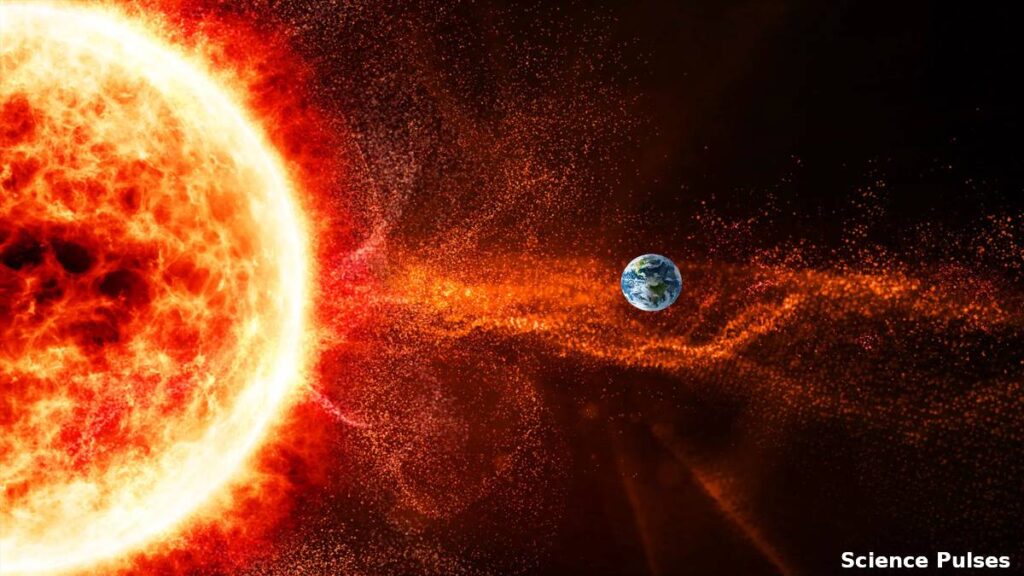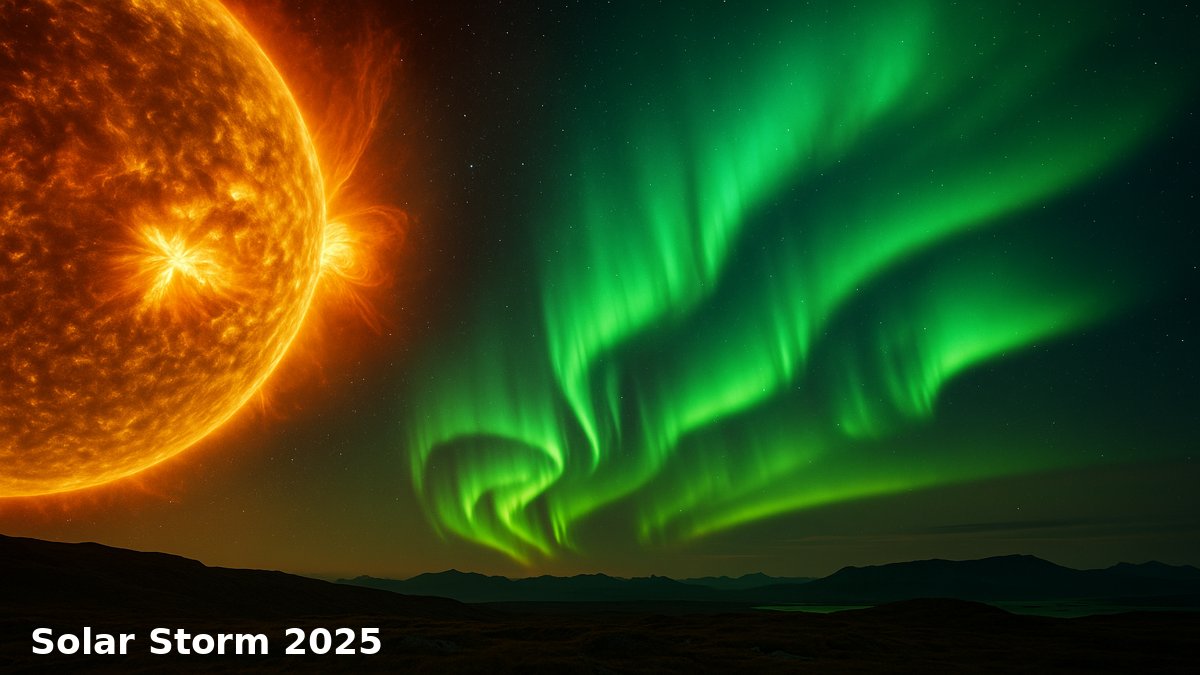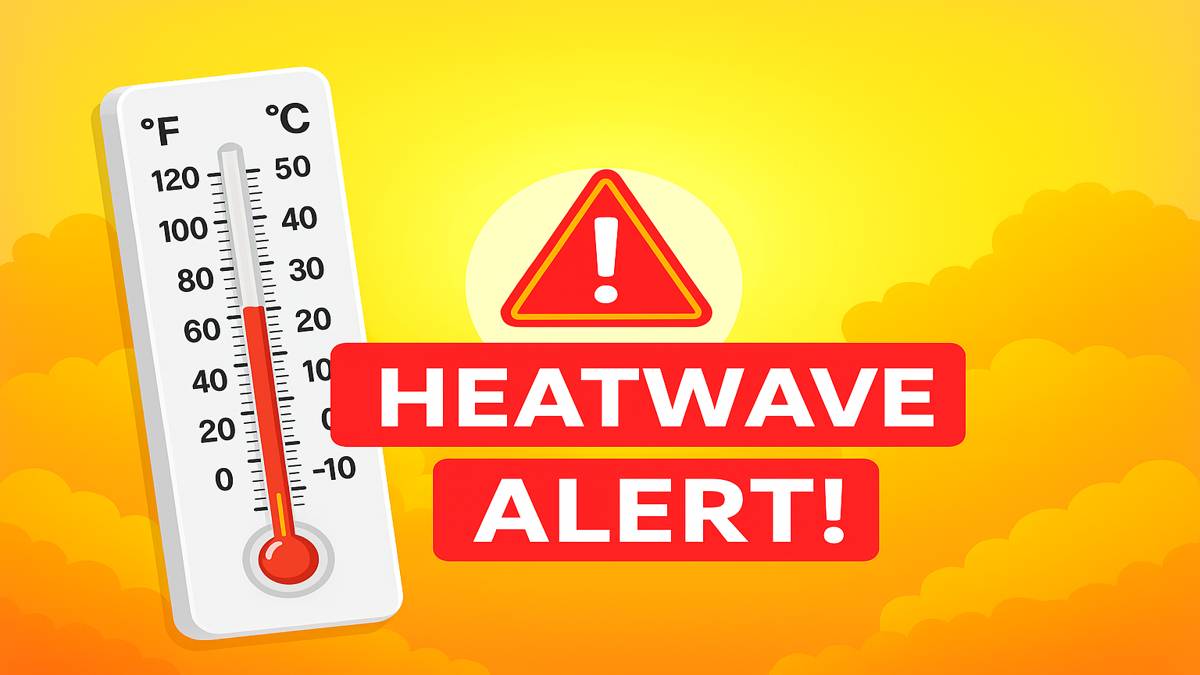Solar Storm 2025 is gaining global attention as Solar Cycle 25 nears its peak in mid-2025. Now, the NOAA Space Weather Prediction Center (SWPC) has not only issued a G1 (Minor) geomagnetic storm watch for July 2–3, 2025, but also confirmed that the coronal mass ejection (CME) has officially impacted Earth as of July 3. Scientists warn that this period brings a high likelihood of space weather disruptions — including satellite interference, GPS drift, radio blackouts, and visible auroras at high latitudes.
Recent geomagnetic storm alerts in June 2025, along with this active storm, show how real the threat is — and what it could mean for our hyper-connected world. As solar activity continues to intensify, experts are watching closely, calling this one of the most significant space weather events of the decade.

Just like the 2025 heatwave emergency, this solar storm reminds us how vulnerable modern life is to natural forces
🚨 Latest Solar Storm 2025 Alert for July
The NOAA Space Weather Prediction Center (SWPC) issued a G1 (Minor) geomagnetic storm watch for July 2–3, 2025, following a coronal mass ejection (CME) that erupted from the Sun on June 28.
This CME has now impacted Earth, confirming minor geomagnetic storm conditions as of July 3.
G1-class storms are considered minor but can still affect satellite communications, GPS accuracy, radio signals, and increase aurora visibility in northern regions.
This event marks another step in the ongoing escalation of Solar Cycle 25, which is expected to peak around mid-2025.
🔗 Official Source: NOAA SWPC Alert for July 2–3, 2025
🌐 What Is the Solar Storm 2025?
A solar storm is the disturbances in the sun that emit high-energy particles and radiation to space. These are usually a result of solar flares and/or coronal mass ejections (CMEs). These solar storms cause the solar wind to send a wave of charged particles to Earth. Upon contact with our magnetic field, they initiate a geomagnetic storm that can affect devices, systems and even impact nature.
According to NASA, ‘solar storm 2025’ is predicted to be one the of strongest in recent years, possibly pushing a G4 on the geomagnetic scale, which has the potential to affect systems globally.
🛰️ NASA’s Alert: What Makes Solar Storm 2025 So Dangerous?
NASA has issued a warning, and referenced the NOAA Space Weather Prediction Center’s data on possible catastrophic consequences:
📡 Satellite Failure
Satellites that currently provide GPS, weather forecasting, and communications are at risk of functioning incorrectly. In historical solar storms, we have observed multi-hour outages in GPS and several hours in satellite TV.
⚡ Power Blackout
Electrical infrastructure is susceptible. A storm in 1989 caused a 9-hour blackout in Quebec. Other, similar storms may happen again if grid systems were overloaded.
📶 Internet and Radio Blackouts
Shortwave radio communications could fail, and even satellite-based internet (like Starlink) could experience signal loss.
🚨 “This storm could test our global tech resilience,” said Dr. Helena Cross, a NASA solar physicist.
🧲 Earth’s Magnetic Shield: Protection & Pressure
Under normal circumstances, Earth’s magnetosphere protects us from harmful solar particles. If solar storms are severe, such as the one scientists are expecting in July 2025, the magnetosphere gets compressed and allows energy to enter more readily.
That can lead to potential issues such as:
- Transformer failures
- Pipeline corrosion
- GPS drift
- Auroras at lower latitudes than usually expected
The higher the severity of the solar storm, the greater the pressure it can put on our magnetic field. Hence, explaining the anxiety surrounding this event.
📅 When Will Solar Storm 2025 Hit Earth?
NOAA has officially issued a G1-level geomagnetic storm 2025 watch for July 2–3, following a coronal mass ejection (CME) that erupted on June 28. Experts continue to warn that solar activity is intensifying as Solar Cycle 25 nears its peak. Previously, NOAA issued a G2-level storm watch for June 24–25, and solar flares as recent as June 17 have shown increasing intensity.
During this window, you may notice:
- GPS glitches
- Aurora activity in unusual locations
- Radio blackouts on high frequencies
- Minor voltage instability in power systems
🌌 Can You See the Northern Lights During Solar Storm 2025?
Yes — and that’s one of the most beautiful side effects. A strong solar storm, like this one, can push auroras further south than normal. This means residents in:
- Central Europe
- Northern U.S. states (like Michigan and Minnesota)
- Parts of Northern Asia
- could see stunning aurora borealis multi-colored displays across the nighttime sky in early July.
- To get the best viewing:
- Stay away from city lights
- Check real-time aurora forecasts at Aurora Forecast NOAA
🛠️ How to Prepare for the Solar Storm 2025?
While solar storms can cause problems with modern life, they don’t actually hurt humans. Here are some ways to be prepared:
✅ Charge Your Devices:
Charge the phones, laptops, or power banks you may need before the forecasts I sent out above.
✅ Backup Critical Files:
To save your files from being wiped out by blackouts or no signal, backup your files to a cloud service like google drive, dropbox, or an external hard drive.
✅ Stay Current:
You can follow live updates from:
- NASA Solar Updates
- NOAA Space Weather Prediction Center
✅ Skip the Polar Flights (If You Are Traveling):
Solar radiation is always worse over the poles. Many airlines change routes during active storms.
“In a world already changing due to AI-driven automation, events like solar storm 2025 show how much we still rely on fragile systems.
📝 Conclusion: Why Solar Storm 2025 Matters More Than Ever?
The solar storm 2025 isn’t just an event happening in space. It’s a warning for an increasingly fragile and over dependent world. NASA and NOAA have both warned of potential disruptions to GPS, satellites, and overall disruptions of power grids in the near future. At this point can we take space weather seriously.
We are currently in a year of scientific discovery, such as 2025 discovers a new organ in the human body, but clearly, nature is still boss. Staying aware (to be honest), prepared, and connected to good science can not only mean the difference between chaos and control.
🔎 Disclaimer
As of June 2025, no specific solar storm date has been confirmed by NASA or NOAA. This article discusses possible scenarios based on current solar activity patterns and expert projections.
❓ Frequently Asked Questions (FAQs)
🌞 What is the solar storm 2025, and why is NASA concerned?
The solar storm 2025 is a predicted geomagnetic event caused by a massive coronal mass ejection (CME) from the Sun. NASA is concerned because it could affect power grids, satellites, GPS, and communication systems worldwide.
📡 Will the solar storm 2025 impact mobile phones or internet services?
While the storm may not directly damage phones, it can interrupt satellite-based services such as GPS, Starlink, and aviation communication. Ground internet may also be affected in rare cases of power instability.
🧲 Can a solar storm be dangerous to humans?
Not directly. Earth’s magnetic field protects us from most solar radiation. However, astronauts in space and passengers on high-altitude polar flights may be slightly more exposed to radiation during such events.
🌌 Will I be able to see the aurora during the solar storm 2025?
Yes, possibly. If the storm reaches strong levels, auroras may be visible in areas far south of their usual zones. Keep an eye on the NOAA aurora forecast for real-time updates.




